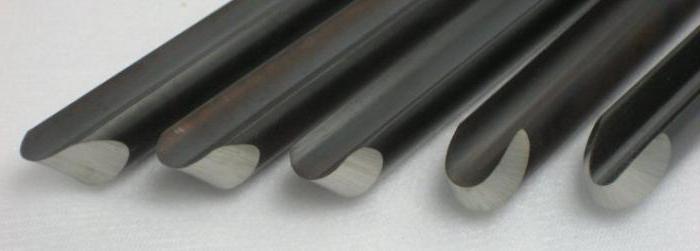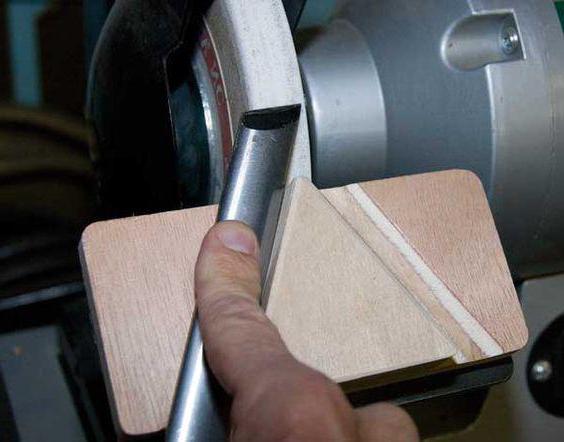You can give the desired decoration to wooden cylindrical products using such special hand tools as a wood cutter for a lathe. The attention of those who like tinkering, presented a wide range of these cutting devices. Everyone can purchase the turning chisel he needs.
However, such products are expensive, and most craftsmen prefer to work with homemade cutters for a wood lathe. What is a tool like? How to use it correctly? Is it possible to make it at home? The answers to these questions are contained in the article.
Acquaintance
The cutter for a wood lathe is a special cutting tool, with the help of which a controlled removal of an unnecessary amount of material from the workpiece is carried out.
Chisels, depending on the work performed, come in various configurations. Many turners use their own exclusive highly specialized cutting turning tools.
Design
Cutters for a wood lathe contain a metal working part and a wooden handle.
The working part consists of the following sections:
- Cutting, or blades. In this area, the tool interacts with the workpiece. It is sharpened as necessary.
- The main site, or "body". While the cutter is working on a wood lathe, the master, holding the “body” with his second hand, securely fixes the cutter.
- Shank. This section of the chisel has a narrowed shape. It smoothly passes into the handle and is firmly fixed there.
The wooden handle consists of two parts:
- The basics. The master holds this section of the tool in his hand.
- The necks are a small cylindrical part for which a metal mounting ring is provided. Its presence prevents the formation of cracks when pushing the handle onto the shank.
The main types of cutters for wood lathes
Masters, working with wooden cylindrical products, use the following cutting tools:
- Reyers. These chisels perform rough, rough and initial processing of workpieces. The tool is equipped with a semicircular blade. For its independent manufacture, you can use a thick plate or groove with a semicircular section.
- Meysels. These chisels are finishing wood products. With this model, the workpiece is given the final shape. In addition, using the Meisel, the master can cut off unnecessary residues from the product. The shape of the chisel is the same as in the knife-jamb: the plate is characterized by the presence of an oblique blade with double-sided sharpening.
Shaped tools
With the help of raisers and maisels, work of medium complexity is carried out. Finer operations are possible with the following shaped cutters for a wood lathe:
- Chisels-scraper. The tool is characterized by a straight form and one-sided sharpening. With this cutter, you can align the cylindrical surface of the product.
- Combs It applies carving, decorative grooves and dashes.
- Hook and rings. With these incisors, cavities are machined in a wooden product.
- Chisels-triangle. Using this shaped model, the workpiece can be given the desired cylindrical shape. According to the reviews of the masters, working with this chisel is very safe. This is due to the fact that the blade has a triangular shape, so that the area of interaction of the cutter with the workpiece is small.
Preparing to make a tool
To make with your own hands a cutter for a wood lathe at home is easy if you have:
- Metal for the future chisel. Judging by numerous reviews, good incisors are obtained from old files, rasps and car springs. You can also use various pipe cuttings and fittings. It is desirable that they have a square section.
- Wooden handle. It is considered an indispensable element for the future torch, as it provides its convenient retention during operation. Some craftsmen buy ready-made pens. However, it is not difficult to grind it yourself.
- Metalworking machine. As this device, you can use any installation equipped with an emery wheel.
- Overalls: goggles, gloves and a lab coat. During operation, hot sparks and metal chips are formed. The presence of protective special equipment will protect the master from injury.
Working process
To make high-quality chisels for wood, it is important to follow the standard algorithm:
- Create a drawing of the future cutter. Putting it on the metal, carefully cut the desired shape.
- Initialize the product on an abrasive wheel.
- Temper the workpiece. To do this, you need to heat the metal to a maximum temperature, and then place it in a container with used engine oil. Only remove the product after it has completely cooled down. Judging by the reviews, some craftsmen carry out hardening without oil, and let their homemade products cool in the air. This procedure is required, since it is hardened cutters that are suitable for working with wood of various hardness.
- To process a product, using a grinding skin.
- Finish sharpening on a metalworking machine.
- Push the metal part onto the wooden handle.
How to sharpen cutters for a wood lathe
The surface quality of the workpiece processed by it will depend on how correctly sharpened the working tool is. The sharpness of the incisors is formed on electric metalworking machines equipped with circles of different grit. At what angle to sharpen the tool, each master decides for himself. For beginners, the following optimal options are presented:
- Meisels should have a sharpening angle of about 40 degrees.
- The value of the standard sharpening angle for racers can vary between 50-60 degrees.

Most turners, as they gain experience, reduce the angles to 20 degrees. Experienced craftsmen recommend having several cutters of the same type with different sharpening angles. This recommendation is due to the fact that a certain degree of sharpness of the cutter is intended for processing each tree species. For example, with solid wood at the initial stage it is more convenient to work with a tool with obtuse angles. Sharp ones are intended for removal from the workpiece of a larger volume. Thus, a sharp-angle cutter can significantly speed up the process. However, in this case, the master is at great risk, because in this mode the blades are very often damaged, which entails the formation of chips on the workpiece. It is recommended to start sharpening with coarse-grained circles. The fine-grained base is intended exclusively for finishing work.

The value of the angle of sharpening, which will be given to the cutter, should be considered before hardening a homemade tool. It is at the initial stage that the working part is molded. The final fine-tuning in the absence of a metalworking machine with a fine-grained emery wheel is easy to carry out using a velvet bar.
Finally
The process of making homemade cutters is not an easy task, but very exciting. Having all the necessary tools, high-quality raw materials and following the algorithm of actions, it will not be difficult to make a good cutter even at home.